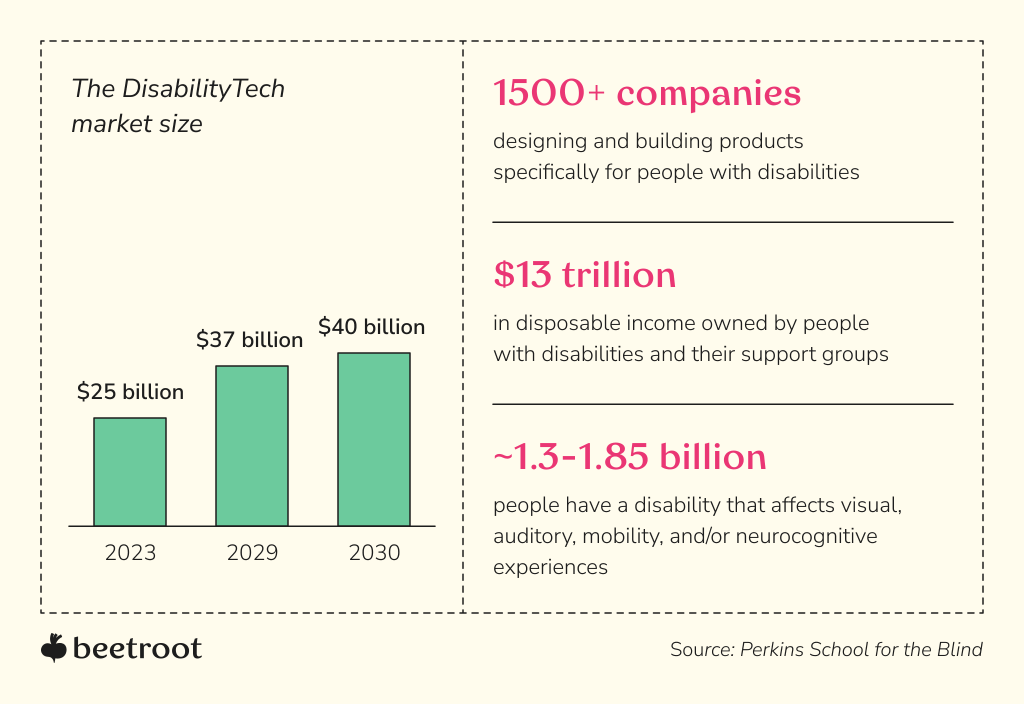
Key Insights into the Surging Market: Assistive Technology in Healthcare
Contents
Contents
Driven by technology advancements, among them the growing role of the medical Internet of Things, the next few years promise to bring seismic changes to the healthcare industry. The global healthcare information technology market, valued at an impressive USD 309.2 billion in 2023, is expected to reach a truly colossal mark of USD 528.5 billion by 2030, according to Precedence Research.
Assistive technology and health technology share a common goal: to improve health outcomes and quality of life and facilitate better care delivery through technological innovation. Now, let’s dive deeper into some key statistics and developments shaping the market.
DisabilityTech rises, tackling unresolved challenges
The World Health Organization (WHO) reports that over 2.5 billion people need one or more assistive products. This number is projected to surpass 3.5 billion by 2050. Around 16% of the global population live with a disability that affects their visual, auditory, mobility, or neurocognitive functions, which is estimated to be between 1.3 and 1.85 billion people. Unfortunately, their practical challenges are not always well understood and addressed. Yet, as our society becomes more aware of the importance of accessibility and inclusion in education, business, and culture, companies are striving to develop innovative solutions to enhance people’s lives, shaping a new multi-billion market.

Assistive technology market to nearly double in a decade
As a subset of health technology, assistive tech spans a broad range of specialized products, systems, and services—often referred to as ‘living aids.’ These solutions are designed to support, maintain, or enhance an individual’s functional independence and promote their overall well-being. The global assistive technology market is set for significant expansion and is estimated to grow from USD 22.9 billion in 2023 to USD 36.6 billion by 2033.

With the global population aging, the demand for technologies that support older people’s quality of life and independence is on the rise. The integration of smart home systems with AT provides customized solutions for people with disabilities or older adults, enhancing device functionality and performance. However, the high costs of assistive products and inconsistent health insurance coverage restrict access to these devices, limiting the market’s growth potential. Regulatory compliance is a significant challenge in the AT market, with device development and launch subject to diverse regulations and standards. Despite these challenges, as technology evolves, it promises new assistive solutions that cater to a broader user population, making it a promising field for investors and entrepreneurs alike.
Examples of custom assistive software technology
| Assisted living software solutions | Intelligent environments for active, productive, and independent living | Smart IoT solutions, integrated with patients’ wearables and connected to telemedicine systems |
| Assistive communication software | Custom tablet and mobile augmentative communication applications for all age groups | Text-to-speech (TTS) software, speech-to-text software, picture-based communication apps, augmentative and alternative communication (AAC) apps, communication boards/apps |
| Custom assistive technology for vision impairment | Tailored or adaptive solutions designed to meet the individual needs of people with visual impairments or blindness | Custom screen readers, adaptive TTS apps, personalized magnification software, modified reading and writing tools, custom navigation and orientation apps, specialized educational and learning software |
| Assistive technology for hearing impairment | Assistive listening software and smart hearing apps with Bluetooth compatibility, designed to assist deaf and hard-of-hearing users | Speech-to-text and TTS software, sign language recognition and translation software, video relay services (VRS) and video remote interpreting (VRI) software, alerting and notification apps |
| Assistive learning technologies | Software for students with special needs | TTS apps for desktop and mobile devices with multisensory teaching features, literacy support systems, LMSs with speech-to-text functions, Braille printers, audio guidance for the low-vision community, and more |
Recent technological advancements have brought us to the brink of groundbreaking developments. Upcoming technologies can transform assistive technology, adapting it to meet different user requirements. They include:
- Integration of Artificial Intelligence (AI)
- Smart wearable devices and implants
- Human-machine collaboration
- Telehealth advancements
- Robotics in daily assistance
- Advancements in neurotechnology
- Data security and ethical considerations
AI in assistive healthcare technology: research insights
It’s evident that AI has come to last, deepening its impact on various industries. In healthcare, AI involves the use of computers and machine processes to simulate human intelligence and perform complex tasks related to health and medicine. Its role in healthcare systems is growing: 75% of over 150 surveyed health services providers and pharma experts believe AI applications will be widespread within the next three years. Despite market contractions, AI technology in healthcare is set to grow to over USD 187 billion by 2030.
AI is also powering a new generation of solutions that can improve the quality of life and well-being of people who need living aids. The latest developments revolving around AI can be summarized as follows:
- Speech recognition and computer vision are the top AI technologies set to improve communication and interaction with the world for people with functional difficulties.
- Insights and living experiences of people with disabilities are the base for new technologies, leading to more user-centric and practical solutions.
- Innovations for visually impaired people are a prominent trend, aiming to replace traditional aids and provide more resources for blind individuals.
- Big Tech leads the frontier: big-name solutions like Microsoft’s Seeing AI app and Google’s Project Euphonia push the envelope in assistive technology.
- Smart garments offer new ways to help people with daily tasks and health monitoring, thereby broadening the definition of assistive technology.
- Practical challenges remain, including extended device battery life, high cost, securing investment for product development, and more. Addressing these problems should make assistive solutions more scalable and accessible to those who need them most.

Concluding thoughts
Summing up, the intersection of healthcare IT and assistive technology heralds a new era of innovation and growth. As the market for assistive technology surges, driven by technological advancements and a greater focus on user-centric design and data-driven solutions, the potential to transform lives has never been greater. Yet, the journey ahead still poses hurdles. Accessibility and affordability barriers remain.
So, as we look toward a future where technology bridges the gap between ability and aspiration, the role of tech innovators, policymakers, and society at large becomes even more critical. By adopting approaches that value equal access to healthcare services and human-centered design that provides diverse ways for everyone to participate in these experiences, we can foster more inclusive, empathetic, and technologically advanced healthcare ecosystems.
Subscribe to blog updates
Get the best new articles in your inbox. Get the lastest content first.
Recent articles from our magazine
Contact Us
Find out how we can help extend your tech team for sustainable growth.







